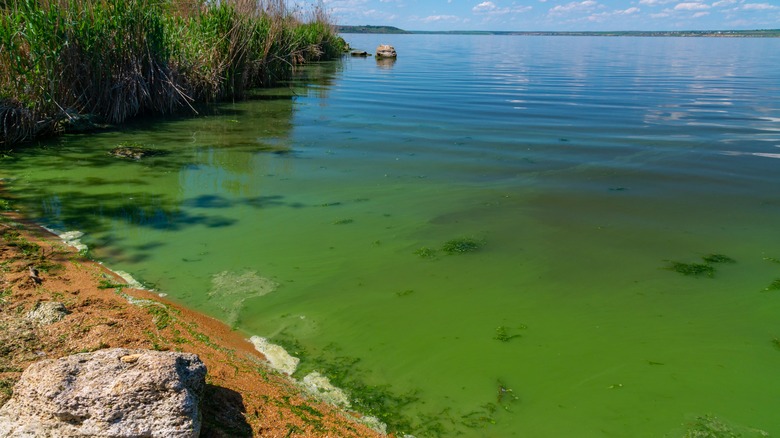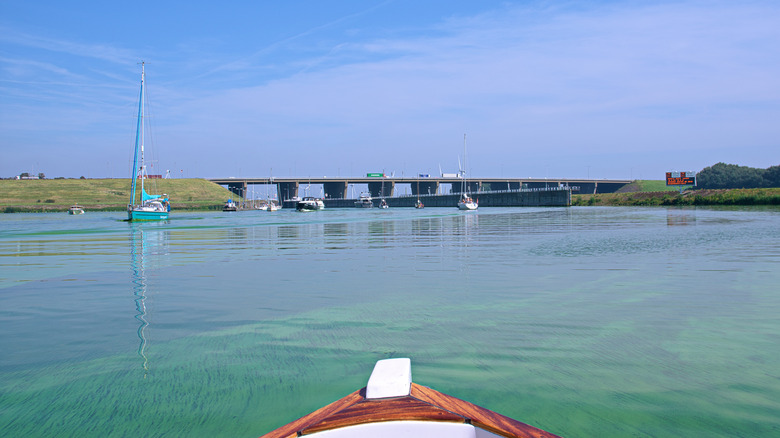Why You Should Keep An Eye Out For This Incredibly Toxic Type Of Algae In Lakes And Rivers
Several of the most visited campsites in the United States are near lakes and rivers. After all, many people consider water access a prerequisite when picking the best spots to camp. This is because lakes and rivers not only enhance the aesthetics of the landscape, they also offer campers opportunities for a variety of activities such as kayaking, canoeing, paddleboarding, fishing, and swimming. However, while people know there are creatures to beware of while swimming in oceans, they may not realize rivers and lakes are filled with potential dangers as well. And, some of the biggest problems are often caused by the smallest organisms.
When air temperatures are at or near their peak during summer and early fall, cooling off in a nearby river or lake is mighty tempting. However, the relief from the heat which the water provides may be offset by some very unpleasant physical ailments if it contains blue-green algae. Ironically, this harmful algal bloom is most often found during the very times of year when it is most appealing to swim. This is why you should keep an eye out for this incredibly toxic type of algae in lakes and rivers.
How to tell if blue-green algae is present
If you are in any lake or river in North America, you are literally swimming with algae, as they are present in every water body. Most of these algae are not harmful to humans and are actually helpful to the ecosystem. While excessive amounts of any algae is detrimental, blue-green algae is very dangerous. Despite the name, blue-green algae isn't actually algae. Rather, it is a bacteria – cyanobacteria. In the right conditions, namely warm water, it can grow quickly, resulting in dense concentrations referred to as blooms.
Blue-green algae blooms can have different appearances and characteristics. Often, dead fish or wildlife may be floating in the water, the water may appear as if a layer of spilled paint is on the surface, and it may emit a distinct odor. The water may be discolored with green streaks, have a thick pea-soup appearance, or have small green dots or matted globs floating on the surface.
While those signs are obvious, sometimes dangerous levels of blue-green algae are harder to detect. There are a couple DIY blue-green algae tests. One, dip a stick in the lake. If it ends up looking like a paint stir stick, blue-green algae is present. Another method is to fill a jar nearly full of water from the lake or river. Seal the lid and let it sit. Material that sinks is actual algae. If a greenish ring forms around the top of water, it is blue-green algae.
Blue-green algae is dangerous for both people and pets
So, other than being unsightly and smelling bad, why does it matter if blue-green algae is present? When found in dense enough concentrations, the toxins released by blue-green algae can be dangerous not just to marine life, but also to humans and animals such as dogs. Blue-green algae actually produce two types of toxins — neurotoxins and hepatotoxins. Neurotoxins affect the nerve system and can cause numbness or tingling sensations, dizziness, weakness, difficulty breathing, and, in severe cases, death. Hepatotoxins impact the liver and typically result in stomach pain and cramps, nausea, diarrhea, and vomiting.
If blue-green algae is present, you or your pet can become sick by swallowing or coming in contact with contaminated water or by inhaling tiny droplets that become airborne. This means you don't actually have to be in the water to be affected by blue-green water. To that end, the Minnesota Pollution Control Agency has a handy chart that ranks exposure risks based on various outdoor activities. If you have been exposed to water contaminated with blue-green algae and develop any of the symptoms listed above, contact a medical professional or call the poison control hotline. Pets exhibiting symptoms should be taken to a veterinarian as soon as possible or contact the ASPCA Poison Control Center.


